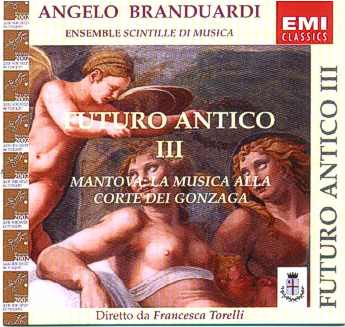
|

Das Bild des CD-Covers ist Teil eines Freskos von Giulio Romano, das sich im Saal der
Psyche des Palazzo Te in Mantua befindet.
La copertina di questo CD fa parte di un affresco di Giulio Romano della Sala di
Psiche in palazzo Te a Mantova.
L'image du CD-Cover est partie d'une fresque de Giulio Romano qui se trouve dans la Salle
de la Psyche du Palazzo Te à Mantoue.
The pic on the CD-Cover is part of a fresco from Giulio Romano, painted in the Room of the
Psyche in Palazzo Te, Mantova.
Es stellt Psyche und Eros dar.
Um dieses Fresko zu sehen auf obenstehendes Bild klicken, dann auf "ovest".
In particolare rappresenta Psiche ed Eros.
Si può vederlo cliccando sulla copertina qui sopra, poi su "ovest".
Il représente Psiche et Eros.
On peut le voir en cliquando sur l'image au-dessus, puis sur "ovest".
It shows Psyche and Eros.
Click on th pic above, then on "ovest" to see this fresco.
Biografie
Biografia
Biography
Back to:
FUTURO ANTICO III
Giulio Romano (ca. 1499 Roma - 1546 Mantova)
Maler und Architekt. Er wurde als Giulio Pippi in Rom geboren und wurde Meisterschüler vom
italienischen Maler Rafael, welchem er bei vielen seiner schönsten, späten Werke assistierte.
Nach Rafaels Tod folgte er ihm als Leiter der Römischen Schule nach.
1524 akzeptierte Giulio die Einladung von Gonzaga, Herzog von Mantua und Patron der
Kunst, um eine Serie von architektonischen und malerischen Werken zu realisieren. Die Entwässerung
der Sümpfe, welche die Stadt umgaben und deren Schutz vor Überschwemmungen der Flüsse Po und Mincio
bestätigen Giulio's Fähigkeiten als Ingenieur. Seine Talente als Architekt entfaltete er in der
Planung und Erbauung des Palazzo Te, der Kathedrale, der Strassen und des herzöglichen Palastes.
Zu seinen Werken aus dieser Zeit gehören die Fresken Psyche, Ikarus und der Fall der Titanen im
Palazzo Te.
Biografia
Giulio Pippi, detto Giulio Romano, pittore e architetto, naque a Roma e diventò il miglior allievo
di Raffaello, assistendolo delle sue ultime e più belle opere. Dopo la morte di Raffaello proseguì
la sua carriera come capo della scuola romana.
Nel anno 1524, Giulio accettò l'invito dei Gonzaga, Duchi di Mantova e promotori dell'arte,
per realizzare una serie di lavori architettonici e pittorici. Il prosciugamento delle paludi
che circondavano la città e il suo sistema di protezione contro le inondazioni dei fiumi Po e
Mincio confermarono le capacità di Giulio come ingegnere. Il suo talento come architetto si realizzò
nella progettazione e costruzione del Palazzo Te, della cattedrale, delle strade e del palazzo
ducale. Fra le sue opere di questo periodo ci sono gli affreschi di Psiche, Icarus e la
caduta dei titani, nel Palazzo Te.
Italian painter and architect. He was born Giulio Pippi in Rome and became the chief pupil of the
Italian painter Raphael, whom he assisted in many of the latter's finest works. At Raphael's death
he succeeded him as head of the Roman school.
About 1524, Giulio accepted the invitation of Gonzaga, ruler of Mantua and patron of the
arts, to carry out a series of architectural and pictorial works. The drainage of the marshes
surrounding the city and its system of protection from the inundations of the Rivers Po and Mincio
attest to Giulio's skill as an engineer; his genius as an architect found scope in the planning and
construction of the Te Palace, the cathedral, the streets, and a ducal palace. Among his works of
this period are the frescoes Psyche, Icarus, and Fall of the Titans, in the Te Palace.  La Celeste Galeria - Il Museo dei Duchi di Mantova
Palazzo Te - Centro Internazionale d'Arte e di Culutra
La Celeste Galeria - Il Museo dei Duchi di Mantova
Palazzo Te - Centro Internazionale d'Arte e di Culutra